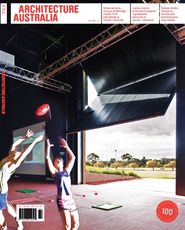This letter is being written so that all members of the RAIA may be made aware of what the Institute’s Executive is doing, the consequences of their actions and the muddled thinking that goes with it.
Following a letter from Frederick Warren published in the January/February 2010 issue of Architecture Australia, David Standen then wrote to the then President Melinda Dodson querying the use of RAIA on some occasions and AIA on other occasions and other inconsistencies. Her reply contained the following:
Firstly the Institute does not officially use “AIA.” Although you will see the acronym used by others, it is not the Institute’s policy to use other than “Australian Institute of Architects,” or when the correlation is clear, the term “Institute.”
RAIA has two uses, first as an acronym, and nothing more, and second as the post-nominal for “Ordinary” members. Its use as an acronym was widespread both within and without the Institute. Its use for the post-nominal remains and no alternative post-nominal has ever been communicated to the membership.
There remain documents in circulation which originated before the adoption of the trading name, which use the acronym RAIA, including the Institute’s Memorandum of Articles.
However, as you are aware, the legal name of the Institute remains “The Royal Australian Institute of Architects” and the Institute continues to use this name when it is legally required to do so, for example, in contractual relationships.
In addition, the continuation of the legal name is apparent to all, as is required of the use of trading names, for Institute correspondence and many documents contain the words: “The Royal Australian Institute of Architects trading as Australian Institute of Architects.”
Despite yours and Mr Warren’s objections, there is no doubt that a considerable majority of the Institute’s members clearly indicated in 2001 their preference for deletion of the word “Royal.” Assertions that the members were not consulted or that the decision of the Institute’s governing body to adopt the trading name was somehow undemocratic, are not well-founded.
This reply did not answer any of David Standen’s questions. It only served to show that the Executive had no very clear understanding of what they were doing, but were determined to do it.
The letters RAIA are an abbreviation and have the same meaning and status as if written out in full and are interchangeable. An acronym is simply an abbreviation which can form a pronounceable word. Check a dictionary! Their use as a post-nominal clearly states that Institute members are members of the Royal Australian Institute of Architects and nothing else.
The President agreed that the legal name of the Institute is “The Royal Australian Institute of Architects.” This therefore is the only name that should be used on publication documents, letterheads, etc. Any other name being used is clearly an illegal one.
A trading name was a fine idea but it ignored the fact that the Institute is not an ordinary company. It does not trade (manufacture and/or supply goods and services to the public in exchange for money). There is nothing in the Constitution/Memorandum and Articles of Association which permits the Institute to be involved in trading activities. There are no trading activities to which a trading name can be attached. So the idea is irrelevant and ridiculous. It does not change the name of the Institute or the status of its members. It is only a pretence which confuses and misleads anyone who has dealings with the Institute.
Organizations have a Constitution/Memorandum and Articles of Association for the purpose of providing a framework for good governance, to try to prevent executives and governing bodies from acting other than in accordance with members’ properly determined authority and to safeguard the rights of dissenting members.
The references to a 2001 survey are questionable. It has been found out that the 2001 survey was carried out by a marketing survey company seeking opinions. This survey covered Institute members (one does not know who or how many or what questions were asked of them), stakeholders (whoever they might have been) and the general public, as stated by Greg Hughes in a letter to Frederick Warren.
We were not involved in this survey and did not know anything about it at the time, nor have we ever been able to find any members who were surveyed. Frederick Warren was not told who were “stakeholders” or why they were regarded as “stakeholders.” The only stakeholders in this issue are in fact members. No one else can be a stakeholder.
The inclusion of the last two groups clearly indicates that its purpose was to produce support for the Executive’s/National Council’s push for a name change. We do not recall any National Councillors being voted in on a mandate to change the Institute’s name. The President cannot claim a majority of members being in favour of a name change if not all members were included in this survey. Clearly they were not. The only valid vote regarding a name change was the referendum held in the late 1990s, which involved all members and was carried out in accordance with the requirements of the Constitution/Memorandum and Articles of Association. This failed to get sufficient votes to effect a change. That should have been the end of the matter.
The activities of the Executive and National Council in seeking to change the name of the Institute, which appeared to be contrary to the Institute’s Constitution/Memorandum and Articles of Association, were referred to by Frederick Warren. In their response they advised that: “The Constitution is the contract between the Royal Australian Institute of Architects and its members. Therefore a breach of the Constitution would be deemed a breach of contract.”
Even those members who support the name change must see that all this current confusion over what is the Institute’s name, what name is to be used and when and all the actions of the Executive and National Council which are of doubtful validity can damage the public image of the Institute and the image of architects generally. It is therefore time to end this experiment instigated by the Executive and National Council and return to the Institute’s good and legal name, which everyone knew, understood and respected and which caused no confusion with the American Institute of Architects.
Frederick C. Warren APTC (Arch), FRAIA, RIBA
David Standen AM, BArch, LFRAIA, Hon FNZIA
In reponse
Nothing in the Institute’s Constitution disallows “trading.” The Institute has for a very long time “traded” to supplement its membership subscriptions, selling books (including those by Mr Standen), blank contracts and tickets to events, to name just a few items.
A trading name is not unusual for a professional association. For many years Engineers Australia has been the trading name of The Institution of Engineers (Australia), which remains its legal name. Similarly, The Royal Australian Institute of Architects (with capitalized “The”) remains the legal name of the guarantee company incorporated in 1930 (so any acronym should be TRAIA), although then its legal name was Australian Institute of Architects.
National Council’s November 2001 Minutes record: “Council notes the result of the Poll of Corporate Members in respect to the proposal to delete the word ‘Royal’ from the name of the Institute was 1532 agree and 1034 disagree. That is 59.7% of those responding agree with the proposal …”
Confusion over the 2001 poll and a study conducted around 2007 by a marketing consultancy is not of the Institute’s making. National Council considered the 2007 findings in deciding to adopt a trading name.
To remove any doubt, the Articles of Association continue to provide that the official post-nominal for Level 1 Corporate Members is “RAIA.” The Institute does not use the abbreviation “AIA,” but it cannot control its use by others, including casual use by its members.
Richard Barton RAIA,
General Counsel and Company Secretary, Australian Institute of Architects
Source

Archive
Published online: 7 Oct 2011
Words:
Frederick Warren,
David Standen,
Richard Barton
Issue
Architecture Australia, July 2011














